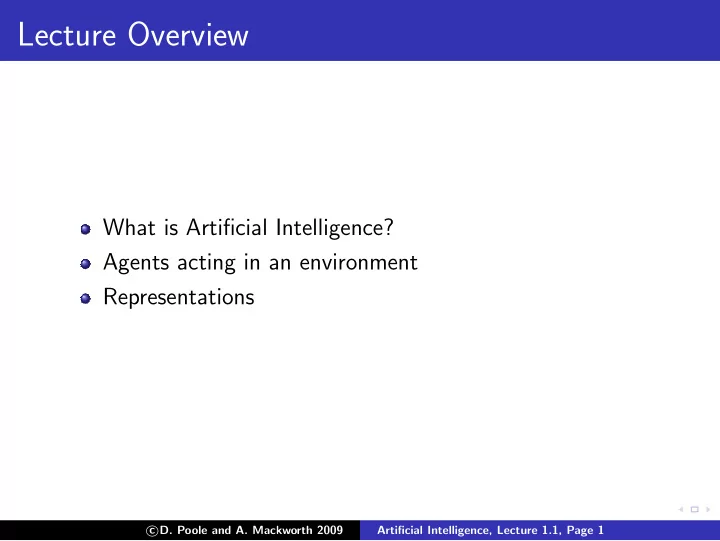

Lecture Overview What is Artificial Intelligence? Agents acting in an environment Representations � D. Poole and A. Mackworth 2009 c Artificial Intelligence, Lecture 1.1, Page 1
What is Artificial Intelligence? Artificial Intelligence is the synthesis and analysis of computational agents that act intelligently. An agent is something that acts in an environment. An agent that acts intelligently if: ◮ its actions are appropriate for its goals and circumstances ◮ it is flexible to changing environments and goals ◮ it learns from experience ◮ it makes appropriate choices given perceptual and computational limitations � D. Poole and A. Mackworth 2009 c Artificial Intelligence, Lecture 1.1, Page 2
Goals of Artificial Intelligence? Scientific goal: to understand the principles that make intelligent behavior possible, in natural or artificial systems. ◮ analyze natural and artificial agents; ◮ formulate and test hypotheses about what it takes to construct intelligent agents; ◮ design, build, and experiment with computational systems that perform tasks that require intelligence. Engineering goal: to specify methods for the design of useful, intelligent artifacts. Analogy between studying flying machines and thinking machines. � D. Poole and A. Mackworth 2009 c Artificial Intelligence, Lecture 1.1, Page 3
Agents acting in an environment Abilities Goals/Preferences Agent Prior Knowledge Observations Actions Past Experiences Environment � D. Poole and A. Mackworth 2009 c Artificial Intelligence, Lecture 1.1, Page 4
Example agent: robot abilities: movement, grippers, speech, facial expressions,. . . observations: vision, sonar, sound, speech recognition, gesture recognition,. . . goals: deliver food, rescue people, score goals, explore,. . . past experiences: effect of steering, slipperiness, how people move,. . . prior knowledge: what is important feature, categories of objects, what a sensor tell us,. . . � D. Poole and A. Mackworth 2009 c Artificial Intelligence, Lecture 1.1, Page 5
Example agent: teacher abilities: present new concept, drill, give test, explain concept,. . . observations: test results, facial expressions, errors, focus,. . . goals: particular knowledge, skills, inquisitiveness, social skills,. . . past experiences: prior test results, effects of teaching strategies, . . . prior knowledge: subject material, teaching strategies,. . . � D. Poole and A. Mackworth 2009 c Artificial Intelligence, Lecture 1.1, Page 6
Example agent: medical doctor abilities: operate, test, prescribe drugs, explain instructions,. . . observations: verbal symptoms, test results, visual appearance. . . goals: remove disease, relieve pain, increase life expectancy, reduce costs,. . . past experiences: treatment outcomes, effects of drugs, test results given symptoms. . . prior knowledge: possible diseases, symptoms, possible causal relationships. . . � D. Poole and A. Mackworth 2009 c Artificial Intelligence, Lecture 1.1, Page 7
Example agent: user interface abilities: present information, ask user, find another information source, filter information, interrupt,. . . observations: users request, information retrieved, user feedback, facial expressions. . . goals: present information, maximize useful information, minimize irrelevant information, privacy,. . . past experiences: effect of presentation modes, reliability of information sources,. . . prior knowledge: information sources, presentation modalities. . . � D. Poole and A. Mackworth 2009 c Artificial Intelligence, Lecture 1.1, Page 8
Representations solve problem solution informal interpret represent formal compute output representation Example representations: machine language, C, Java, Prolog, natural language � D. Poole and A. Mackworth 2009 c Artificial Intelligence, Lecture 1.1, Page 9
Defining a Solution Given a problem, what is a solution? An optimal solution to a problem is one that’s the best solution according some measure of solution quality. A satisficing solution is one that’s good enough. An approximately optimal solution is one whose measure of quality is close to the best that could theoretically be obtained. A probable solution is one that is likely to be a solution. � D. Poole and A. Mackworth 2009 c Artificial Intelligence, Lecture 1.1, Page 10
What do we want in a representation? We want a representation to be rich enough to express the knowledge needed to solve the problem; as close to the problem as possible: compact, natural and maintainable; amenable to efficient computation; able to express features of the problem that can be exploit for computational gain and able to trade off accuracy and computation time/space able to be acquired from people, data and past experiences. � D. Poole and A. Mackworth 2009 c Artificial Intelligence, Lecture 1.1, Page 11
Physical symbol system hypotheses A symbol is a meaningful physical pattern that can be manipulated. A symbol system creates, copies, modifies and destroys symbols. Physical symbol system hypothesis: A physical symbol system has the necessary and sufficient means for general intelligent action. � D. Poole and A. Mackworth 2009 c Artificial Intelligence, Lecture 1.1, Page 12
Levels of abstraction The knowledge level is in terms of what an agent knows and what its goals are. The symbol level is a level of description of an agent in terms of what reasoning it is doing. � D. Poole and A. Mackworth 2009 c Artificial Intelligence, Lecture 1.1, Page 13
Reasoning and acting Reasoning is the computation required to determine what an agent should do. Design time reasoning and computation is carried out by the designer the agent. Offline computation is the computation done by the agent before it has to act. Background knowledge and data � knowledge base . Online computation is the computation that’s done by an agent between receiving information and acting. � D. Poole and A. Mackworth 2009 c Artificial Intelligence, Lecture 1.1, Page 14
Recommend
More recommend